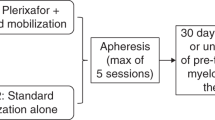Summary:
Pegfilgrastim is equivalent to daily filgrastim after standard dose chemotherapy in decreasing the duration of neutropenia. Daily filgrastim started within 1–4 days after autologous stem cell transplant (ASCT) leads to significant decrease in time to neutrophil engraftment. We undertook a study of pegfilgrastim after high-dose chemotherapy (HDC) and ASCT. In all, 38 patients with multiple myeloma or lymphoma, eligible to undergo HDC and ASCT, were enrolled. Patients received a single dose of 6 mg pegfilgrastim subcutaneously 24 h after ASCT. There were no adverse events secondary to pegfilgrastim. All patients engrafted neutrophils and platelets with a median of 10 and 18 days, respectively. The incidence of febrile neutropenia was 49% (18/37). Neutrophil engraftment results were compared to a historical cohort of patients who received no growth factors or prophylactic filgrastim after ASCT. Time to neutrophil engraftment using pegfilgrastim was comparable to daily filgrastim and was shorter than in a historical group receiving no filgrastim (10 vs 13.7 days, P<0.001). Pegfilgrastim given as a single fixed dose of 6 mg appears to be safe after HDC and ASCT. It accelerates neutrophil engraftment comparable to daily filgrastim after ASCT. Pegfilgrastim may be convenient to use in outpatient transplant units.
This is a preview of subscription content, access via your institution
Access options
Subscribe to this journal
Receive 12 print issues and online access
$259.00 per year
only $21.58 per issue
Buy this article
- Purchase on Springer Link
- Instant access to full article PDF
Prices may be subject to local taxes which are calculated during checkout

Similar content being viewed by others
References
Bearman SI, Appelbaum FR, Back A et al. Regimen-related toxicity and early posttransplant survival in patients undergoing marrow transplantation for lymphoma. J Clin Oncol 1989; 7: 1288–1294.
Schmitz N, Dreger P, Zander AR et al. Results of a randomised, controlled, multicentre study of recombinant human granulocyte colony-stimulating factor (filgrastim) in patients with Hodgkin's disease and non-Hodgkin's lymphoma undergoing autologous bone marrow transplantation. Bone Marrow Transplant 1995; 15: 261–266.
Bence-Bruckler I, Bredeson C, Atkins H et al. A randomized trial of granulocyte colony-stimulating factor (Neupogen) starting day 1 vs day 7 post-autologous stem cell transplantation. Bone Marrow Transplant 1998; 22: 965–969.
Molineux G, Kinstler O, Briddell B et al. A new form of Filgrastim with sustained duration in vivo and enhanced ability to mobilize PBPC in both mice and humans. Exp Hematol 1999; 27: 1724–1734.
Molineux G . Pegylation: engineering improved biopharmaceuticals for oncology. Pharmacotherapy 2003; 23: 3S–8S.
Molineux G . The design and development of pegfilgrastim (PEG-rmetHuG-CSF, Neulasta). Curr Pharm Des 2004; 10: 1235–1244.
IBMTR Core Instruction Manual 2/2002, version 2, pp 22–23.
Holmes FA, Jones SE, O’Shaughnessy J et al. Comparable efficacy and safety profiles of once-per-cycle pegfilgrastim and daily injection filgrastim in chemotherapy-induced neutropenia: a multicenter dose-finding study in women with breast cancer. Ann Oncol 2002; 13: 903–909.
Holmes FA, O’Shaughnessy JA, Vukelja S et al. Blinded, randomized, multicenter study to evaluate single administration pegfilgrastim once per cycle vs daily filgrastim as an adjunct to chemotherapy in patients with high-risk stage II or stage III/IV breast cancer. J Clin Oncol 2002; 20: 727–731.
Green MD, Koelbl H, Baselga J et al. A randomized double-blind multicenter phase III study of fixed-dose single-administration pegfilgrastim vs daily filgrastim in patients receiving myelosuppressive chemotherapy. Ann Oncol 2003; 14: 29–35.
Bensinger W, Appelbaum F, Rowley S et al. Factors that influence collection and engraftment of autologous peripheral-blood stem cells. J Clin Oncol 1995; 13: 2547–2555.
Acknowledgements
This research was supported by Amgen Inc. (Thousand Oaks, CA, USA). We thank Vanderbilt Ingram Cancer Center Clinical Trials Office for conduct of the study and data collection.
Author information
Authors and Affiliations
Corresponding author
Rights and permissions
About this article
Cite this article
Jagasia, M., Greer, J., Morgan, D. et al. Pegfilgrastim after high-dose chemotherapy and autologous peripheral blood stem cell transplant: phase II study. Bone Marrow Transplant 35, 1165–1169 (2005). https://doi.org/10.1038/sj.bmt.1704994
Received:
Accepted:
Published:
Issue Date:
DOI: https://doi.org/10.1038/sj.bmt.1704994
Keywords
This article is cited by
-
Pegfilgrastim: More Cost Effective and Equally Efficacious Option as Compared to Filgrastim in Autologous Stem Cell Transplant
Indian Journal of Hematology and Blood Transfusion (2019)
-
A comparison of the effect of xinruibai versus filgrastim on hematopoietic reconstruction after allogeneic hematopoietic stem cell transplantation
Italian Journal of Pediatrics (2018)
-
Efficacy of deferred dosing of granulocyte colony-stimulating factor in autologous hematopoietic transplantation for multiple myeloma
Bone Marrow Transplantation (2014)
-
Comparison and modelling of pegylated or unpegylated G-CSF schedules in CHOP-14 regimen of elderly patients with aggressive B-cell lymphoma
Annals of Hematology (2013)
-
Early versus late administration of pegfilgrastim after high-dose chemotherapy and autologous hematopoietic stem cell transplantation
Journal of Cancer Research and Clinical Oncology (2012)



